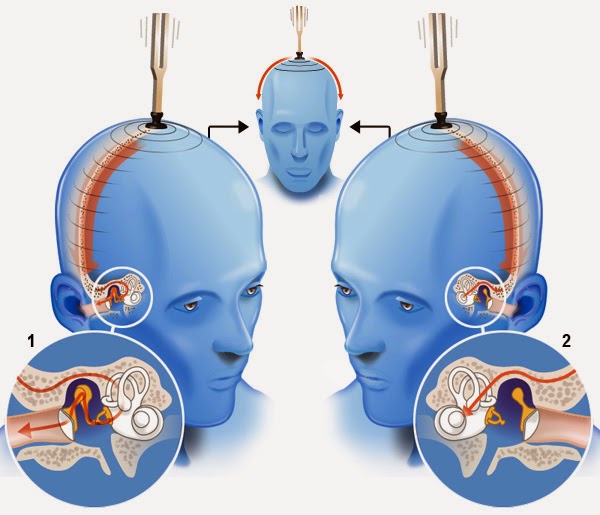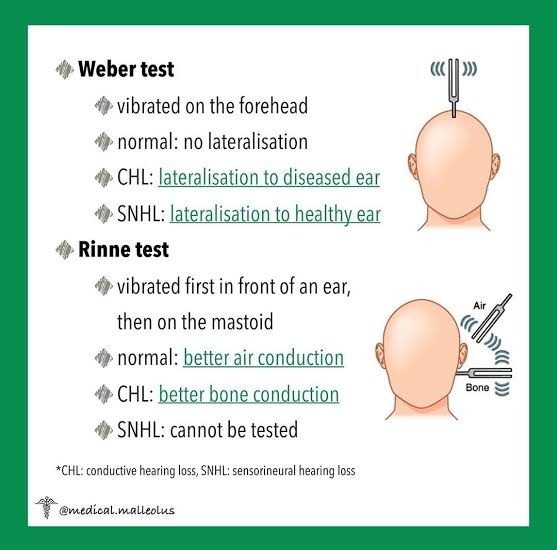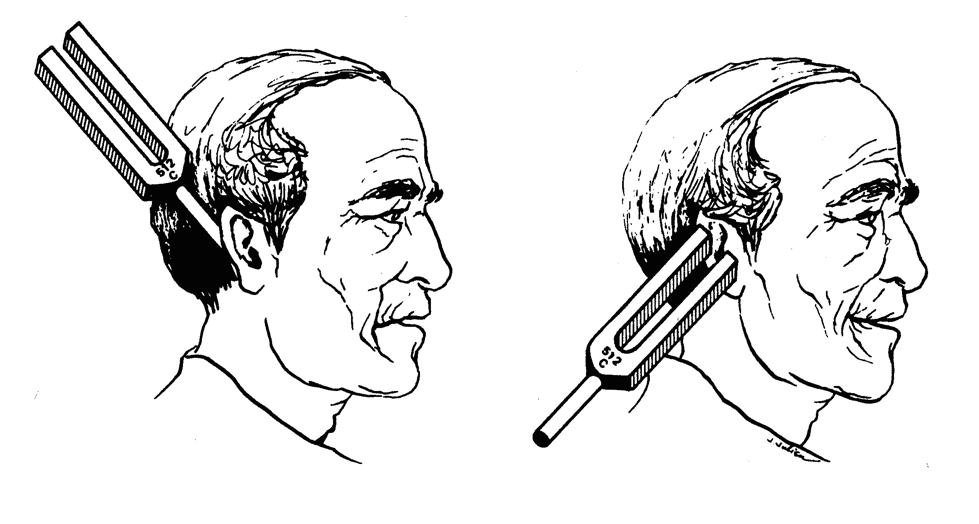
Weber and Rinne Test Nursing mnemonics, Audiology student, Nursing school essential
PROVAS CLÍNICAS DE WEBER E RINNE. As provas de Weber e Rinne comparam a percepção do paciente sobre sua audição por via óssea e aérea. São provas clínicas interpretadas conjuntamente. Para sua realização no exame clínica, são utilizados diapasões. Os mais utilizados são os de 512Hz e 1024Hz. PROVA DE WEBER:

AVALIAÇÃO AUDIOLÓGICA_ AUDIOMETRIA TONAL E VOCAL ACUMETRIA TESTE DE RINNE E WEBER 2022 YouTube
Teste de Weber. Este teste é feito com um diapasão (o qual vibra entre 256 a 512 Hz normalmente) ao ser batido e é colocado ou no centro do crânio com uma distância igual entre as orelhas ou colocado junto do lábio superior. O paciente tem então de ver se nota alguma diferença de audição entre os ouvidos. Se o paciente disser que.

Rinne and Weber Test
Test de Rinne. Le test de Rinne est une procédure clinique d'évaluation de l'audition qui vient en complément du test de Weber. Son objectif principal est de déterminer si la perte auditive est de type conductif ou neurosensoriel. Procédé du test de Rinne. L'examinateur frappe le diapason et le positionne à 2 cm du méat acoustique.

Entendendo de uma vez por todas o teste de Rinne e Weber
Comprendre et réaliser facilement les tests acoumétriques de Rinne et de Weber. Ces tests acoumétriques sont des examens qualitatifs simples, de dépistage de.

Trialmedics Prueba de Weber y Rinne
How to perform Weber's test. Explain to the patient that you are going to test their hearing using a tuning fork. 1. Tap a 512Hz tuning fork and place in the midline of the forehead. The tuning fork should be set in motion by striking it on your knee (not the patient's knee or a table). 2.

Weber & Rinne Test results Interpretation and Clinical Conclusion
Weber test performance. The Weber and the Rinne test (/ ˈ r ɪ n ə / RIN-ə) are typically performed together when the results of each combined to determine the location and nature of any hearing losses detected. In the Weber test a vibrating tuning fork (Typically 256 Hz or 512 Hz used for Weber vibration test; 512 Hz used for Rinne hearing test) is placed in the middle of the forehead.

Weber & Rinne Test Pharmacology nursing, Nursing school studying, Nurse practitioner school
Os testes de Weber e Rinne requerem um diapasão para diferenciar perda auditiva condutiva de neurossensorial. No teste de Weber, a haste de um diapasão de 512 ou 1.024 Hz, vibrando, é colocada na linha média da cabeça, e o paciente indica em qual ouvido o tom é mais alto. Na perda auditiva condutiva unilateral, o tom é mais alto na.
.png)
Weber & Rinne Test results Interpretation and Clinical Conclusion
O teste de Rinne avalia a integridade da via auditiva. É feita com o auxílio de um diapasão de 512 Hertz, o qual é colocado sobre o processo mastoide do paci.

Diapasão Teste de Rinne e Weber Enfermagem Ilustrada
As in Rinne's test, begin by striking the 512 Hz tuning fork against your knee or elbow. Then, place the base of the fork in the midline, high on the patient's forehead. Ask whether they hear the sound in the midline or if the sound lateralises to either the affected or good ear.

Testes de Rinne e Weber Definição e Educação do Paciente Respostas Sempre Atualizadas
Over the years, many types of tuning forks tests had been developed to assess hearing loss, but today only two have withstood the test of time: Rinne and Weber. Both of these tests are now routinely taught in medical schools and performed regularly to assess patients with hearing problems. Heinrich Adolph Rinne (1819-1868), a German otologist, proposed the test, which was subsequently named.

Weber & Rinne Tests Nurse practitioner school, Family nurse practitioner, Nursing school survival
Rinne and Weber tests both use 512-Hz tuning forks to test how you respond to sounds and vibrations near your ears. Rinne test. The doctor strikes a tuning fork and places it on the mastoid bone.

Weber test and Rinne Test
How the test works. While more in-depth testing is necessary to determine the degree of hearing loss, the Weber test is a quick way to screen for both conductive and sensorineural hearing loss in.

Interpreting the WeberRinne Tests EXPLAINED YouTube
These tests should be carried out with a full examination of the cranial nerves or the ear. The Rinne and Weber tests help distinguish between a conductive hearing loss (CHL) and sensorineural Hearing Loss (SHL) Other tuning fork tests include the Schwabach and Bing tests, though these are not used in routine practice.

Hipoacusia Test de Rinne y Weber Chuletas Médicas
Teste de Rinne. Nesse teste é comparada a condução óssea (CO) e a condução aérea (CA) do paciente. Para realizá-lo, existem dois métodos: 1- Deve-se colocar o diapasão ativado primeiro sobre o processo mastoide, e imediatamente, em seguida, ao lado da orelha sem tocá-la. Após isso, pergunta-se ao paciente qual som é o mais intenso.

Rinne & WeberTest Ablauf, Interpretation & mehr Amplifon
Teste de Weber. O teste de Weber ou prova de Weber é um teste clínico rápido para avaliar a audição. O teste foi nomeado em homenagem a Ernst Heinrich Weber (1795 - 1878), um físico e médico alemão. A sua conexão com a audiologia se deu quando descobriu que o uso do diapasão vibrando poderia ser ouvido quando colocado contra o crânio.

Rinne Test — Medlibes Online Medical Library
The Rinne test differentiates sound transmitted through air conduction from those transmitted through bone conduction via the mastoid bone. By comparing air and bone conduction, it helps detect conductive hearing loss in one ear. A Rinne test should be performed in conjunction with a Weber test to help distinguish between conductive hearing.
- Terço Das Chagas De Nosso Senhor Jesus Cristo
- Para Que Serve A Regionalização
- Livro Da Terra A Lua
- Quantos Anos Tem A Cantora Cher
- Quantas Vezes O Papel Pode Ser Reciclado
- Mundial De Clubes Sub 20
- Pmbok E Gerenciamento De Projetos
- Colageno Tipo 1 E Tipo 2
- Data De Lançamento Assassin S Creed Mirage
- Livro Vontade De Saber Historia 8 Ano Pdf